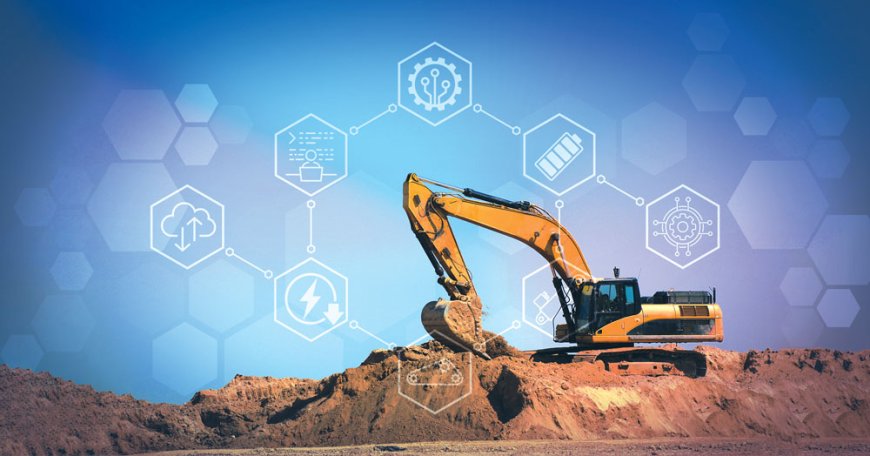AUTOMATION & CONTROLS for SMART MACHINES!
Industry experts claim that manufacturers of construction machinery face the challenge of implementing intelligent and autonomous machine functions quickly and maintaining them over the long term. Equipment Times looks at the current demand trends of construction equipment for construction and mining operations, key digital features and solutions offered for various heavy equipment, future scenario and bottlenecks in the sector.

Industry experts claim that manufacturers of construction machinery face the challenge of implementing intelligent and autonomous machine functions quickly and maintaining them over the long term. Equipment Times looks at the current demand trends of construction equipment for construction and mining operations, key digital features and solutions offered for various heavy equipment, future scenario and bottlenecks in the sector.
Machine connectivity and automation, also known as heavy equipment connectivity, is an increasingly common solution in various fields, including construction, agriculture, mining, waste management, transportation, and beyond. At its core is the constant collection and processing of real-time data, and it requires a capable and accommodating network. Data transfers need an active and reliable connection, so without that network in place, it can’t go anywhere or do anything of note.
The good news is that today’s heavy equipment technology, including smart sensors and data-driven solutions, along with the networks that are needed to support them, is advancing at considerable rates. The rollout of 5G will change the game by extending a reliable and mobile network to places never seen before. It will create a level of heavy equipment telematics far beyond what the previous generation of networks offered.
According to Emily Newton, that advancement alone will introduce many new opportunities in the world of heavy equipment and machinery. What’s more, it will vastly improve how the equipment is used, boost efficiency, and evolve automation applications.
Connectivity Matters
Even in its most basic form, automation requires a steady inflow of data. The data may be simple — sudden movements, objects detected in a hazard area, a blockage in the workflow, or a major malfunction — but it’s there. It stands to reason that adaptive automation systems would require access to not just more complex data, but also faster, more precise information.
Cue modern connectivity, which helps ensure the related systems remain connected and communicating with the appropriate networks. It means all of the data being collected and transmitted can be sent near-instantly to a central hub, with prompt feedback, as well. This heavy equipment connectivity empowers incredible opportunities, such as self-driving equipment or heavy machines that can work without human input.
There are several levels of operation to automated systems. They must follow and process basic rules, or algorithms. While they do that, they must collect a continuous stream of performance, environmental, and conditional data to ensure the work is being done correctly, safely, and without complications. Another set of guidelines governs start and stop functions, and may dictate a delay, like if a worker is detected in an operating lane. It can be likened to a self-driving vehicle on an active roadway.
Those vehicles must be aware of passengers, nearby cars, or pedestrians, what’s happening around them, environmental conditions like rain or inclement weather, and so on. At any time, they must be prepared to slow, brake, or halt operation based on what’s going on, or even what might be about to happen — like a potential collision.
To do that and process the incredibly complex and near-endless streams of information, the automated equipment needs reliable access to a core platform. Think of the neural net in a machine learning or artificial intelligence system.
Empowering Efficiency
Whether you’re talking about a robot or heavy equipment technology running on an automated control system, machines can work more effectively than humans. They don’t tire or burn out, and they don’t need frequent breaks — barring a malfunction or mechanical problem. They aren’t generally affected by environmental conditions, either, like extreme heat or cold, excess humidity, and even hazardous elements.
Once you set an automated machine on its path, it continues to carry out the work until its system requires a delay, or until it experiences a failure of some kind.
More connected and automated heavy machinery will lead to higher levels of efficiency and output for just about any operation out there. Of course, it’s not going to happen overnight, and the systems required to support these platforms will need to be established, as well. But every day we grow closer to that reality.
Superior Safety
Conventional equipment calls for a driver or operator of some kind. In recent years, that has improved thanks to remote solutions, allowing operators to move farther back from the machines or project site. Tomorrow’s heavy equipment technology will allow those machines to function without any humans behind the wheel, or behind a mobile or digital dashboard.
This vastly improves the health and safety of work crews, especially in locations or on job sites where there are dangerous conditions. No longer will workers have to be worried about heavy materials falling around them, nor will they be exposed to job site hazards. The equipment is not going to replace human laborers, either. They’ll merely be free to work on more complex and worthy tasks.
Not to mention, a new subset of service opportunities will open up, as the automated equipment needs to be maintained and cared for.
Unprecedented Uptime
Preventive care or maintenance is always better than reactive. Dealing with failures after they occur often creates even bigger problems later on.
A level beyond preventive care is predictive care, with the help of smart data. It involves taking all of the collected information and utilizing it to care for systems, equipment, tools, and components, as early as possible. The predictive models show what can and will happen, and the maintenance teams administer care to prevent it.
The world is entering an age of robotics. Industrial robots have worked in the manufacturing sector for decades, and now they appear in everything from airports to agriculture. Construction could be the next industry to undergo an automation transformation.
Construction work is well-suited for autonomous machinery. Tasks are typically repetitive, physical, precise and time-sensitive, and most don’t require out-of-the-box or creative thinking. These types of jobs are typically what manufacturers automate first, yet the industry has to fully embrace this advancement.
As the sector’s shortcomings become more apparent and technology advances, this trend is starting to shift.
Recent advances have made autonomous heavy machinery a viable option for construction teams, too. Construction teams may be slow to adopt autonomous heavy equipment since new machines are expensive. That’s why some startups, like SafeAI, have taken a retrofitting approach to automation. Instead of making new self-operating machines, they modify existing trucks, bulldozers and loaders to operate autonomously. Most of these machines work by using a system of cameras and sensors. Data from LiDAR, cameras, GPS, RFID, and even vibration and temperature sensors guide them throughout the workplace safely and efficiently. As the technology behind these sensors improves, autonomous heavy machinery becomes a more reliable, worthwhile investment.
Leaders speak…
 Himanshu Sharma, Head – Marketing and Corporate Communication, B&R Automation, said, “Manufacturers of construction machinery face the challenge of implementing intelligent and autonomous machine functions quickly and maintaining them over the long term. B&R continues to open new possibilities in the automation of mobile machinery or heavy equipment manufacturers with its modular X90 control and I/O system. The system’s comprehensive set of standard components is perfect for implementing flexible automation concepts, which means they can choose controllers from a range of performance classes, ensuring consistent solutions for basic to high-end machines. A variety of option boards for the X90 makes it easy to connect sensors, transmit diagnostics data, or control stepper motors directly. Also, the topic of safety in general are increasingly relevant for manufacturers of mobile or heavy equipment machinery. Mobile controllers with safe, floating outputs have previously not been available on the market. With B&R’s new safety relay module, external safety components such as drives, or laser scanners can now be connected to the X90 controller via a floating-ground emergency stop circuit. In addition, the controller comes in a rugged IP69K housing. Since it does not require a control cabinet or complex wiring, easy service is guaranteed.”
Himanshu Sharma, Head – Marketing and Corporate Communication, B&R Automation, said, “Manufacturers of construction machinery face the challenge of implementing intelligent and autonomous machine functions quickly and maintaining them over the long term. B&R continues to open new possibilities in the automation of mobile machinery or heavy equipment manufacturers with its modular X90 control and I/O system. The system’s comprehensive set of standard components is perfect for implementing flexible automation concepts, which means they can choose controllers from a range of performance classes, ensuring consistent solutions for basic to high-end machines. A variety of option boards for the X90 makes it easy to connect sensors, transmit diagnostics data, or control stepper motors directly. Also, the topic of safety in general are increasingly relevant for manufacturers of mobile or heavy equipment machinery. Mobile controllers with safe, floating outputs have previously not been available on the market. With B&R’s new safety relay module, external safety components such as drives, or laser scanners can now be connected to the X90 controller via a floating-ground emergency stop circuit. In addition, the controller comes in a rugged IP69K housing. Since it does not require a control cabinet or complex wiring, easy service is guaranteed.”
He further added, “The future appears to be more of a technological boom and adaptation to innovations. Also, if sustainability goals are maintained and achieved, we could see sustainable growth in the sector. With improved data monitoring, machine learning, advanced control systems and the introduction of robotics to this industry, there will be a revolution in automation and machine control in the sector.”
 Amit Hatgine, Manager System Business, ifm electronic India, said, “We, ifm electronic are the one of tech-partners, offering Electronics solutions on CE Equipment’s. We are witnessing a major semiconductor shortage which is hampering CE industry. The semiconductor shortage is a growing problem impacting industries from automobiles to construction equipment. Over the past few decades, our machines have become “smarter”, which means they require a great amount of electronics and sensors to operate.
Amit Hatgine, Manager System Business, ifm electronic India, said, “We, ifm electronic are the one of tech-partners, offering Electronics solutions on CE Equipment’s. We are witnessing a major semiconductor shortage which is hampering CE industry. The semiconductor shortage is a growing problem impacting industries from automobiles to construction equipment. Over the past few decades, our machines have become “smarter”, which means they require a great amount of electronics and sensors to operate.
The increased dependence upon technology exposes the construction equipment supply chains to hiccups in technology supply chains. Global manufacturers who are unable to procure semiconductor chips are forced to stop production. Used prices for construction equipment have increased over the past year as a result of higher commodity prices and strong economic demand. We could see an incremental step higher over the next twelve months as a result of semiconductor shortages impacting new machinery production, as well as higher input costs (steel, copper, etc). chips will still be in short supply throughout 2022, and with some component lead times pushing into 2023, meaning that the shortage will have lasted 24 months before it recedes, similar to the duration of the 2008–2009 chip shortage. While the shortage will endure through 2022, it will be less severe than in fall 2020 or most of 2021, and it will not affect all chips.”
Hits: 0








